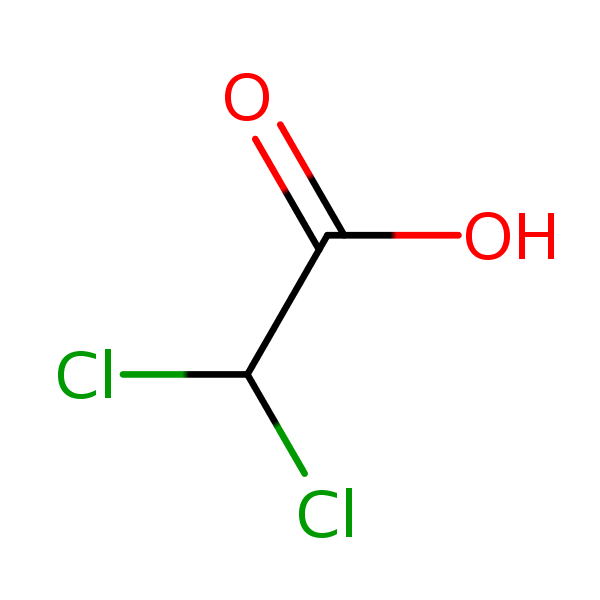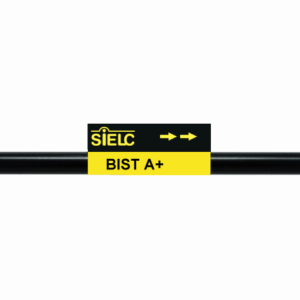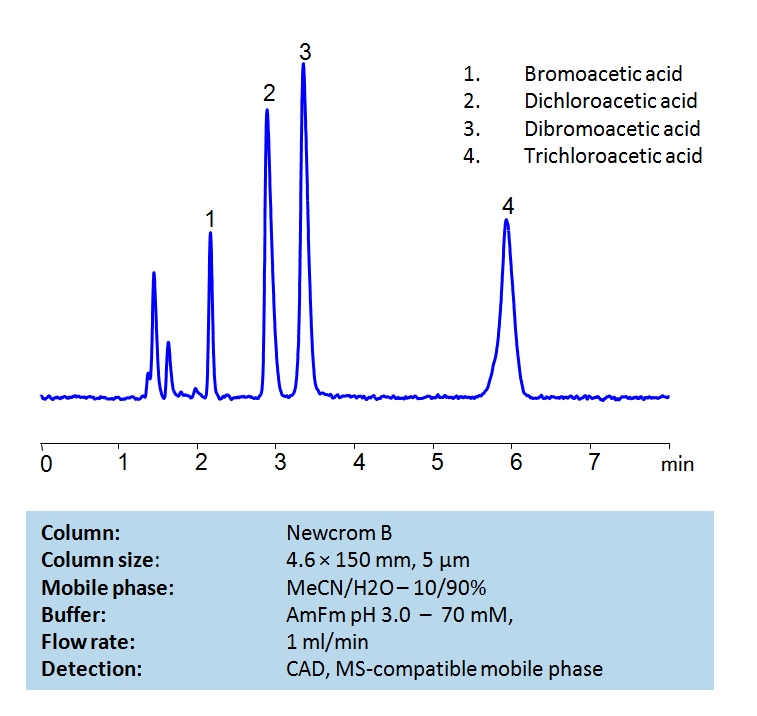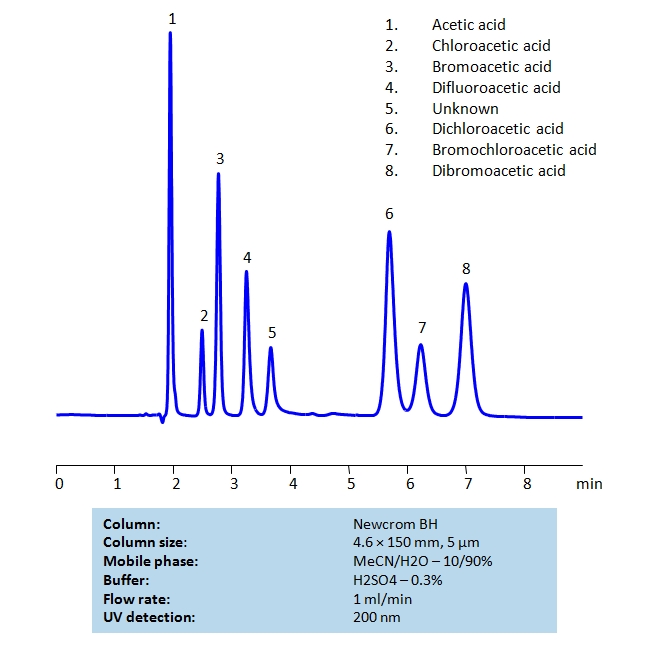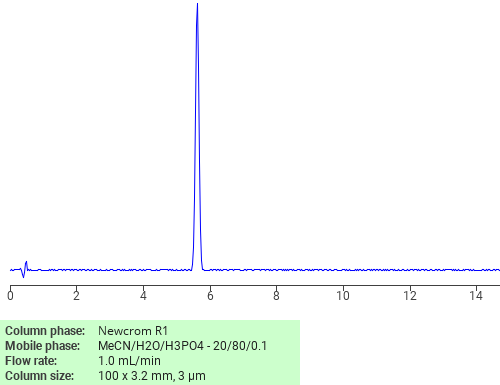| CAS Number | 79-43-6 |
|---|---|
| Molecular Formula | C2H2Cl2O2 |
| Molecular Weight | 128.941 |
| InChI Key | JXTHNDFMNIQAHM-UHFFFAOYSA-N |
| LogP | 0.92 |
| Synonyms |
|
Applications:
HPLC Method for Analysis of Chloroacetic acid, Dichloroacetic acid and Trichloroacetic acid on BIST™ A+ Column
July 7, 2022
Separation type: Bridge Ion Separation Technology, or BIST™ by SIELC Technologies
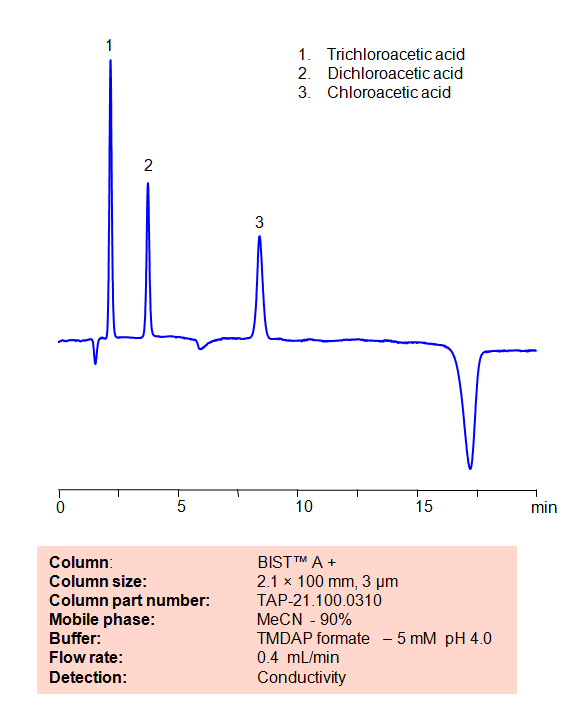
High Performance Liquid Chromatography (HPLC) Method for Analysis of Chloroacetic acid, Dichloroacetic acid and Trichloroacetic acid
Chloroacetic acid is a popular building block in organic syntheses. Dichloroacetic acid and Trichloroacetic acid are frequently used in cosmetic treatments to remove tattos and in chemical peels, as well as topical medication for the ablation of warts. Using SIELC’s newly introduced BIST™ method, a mixture of these three aicds can be separated on a negatively-charged, cation-exchange BIST™ A+ column, contrary to conventional chromatographic wisdom. There are two keys to this retention method: 1) a multi-charged, positive buffer, such as N,N,N’,N’-Tetramethyl-1,3-propanediamine (TMDAP), which acts as a bridge, linking the negatively-charged anion analytes to the negatively-charged column surface and 2) a mobile phase consisting mostly of organic solvent (such as MeCN) to minimize the formation of a solvation layer around the charged analytes. Other positively-charged buffers that can generate BIST™ include Calcium acetate and Magnesium acetate. Using this new and unique analysis method, these anions can be separated, retained, and detected with a Conductivity Detector.
Condition
| Column | BIST™ A+, 2.1×100 mm, 3 µm, 100A |
| Mobile Phase | MeCN – 90% |
| Buffer | TMDAP ( N,N,N’,N’-Tetramethyl-1,3-diaminopropane) formate – 5 mM pH 4.0 |
| Flow Rate | 0.4 ml/min |
| Detection | Conductivity |
Description
| Class of Compounds | Acid, Carboxylic acid, Haloacetic acid |
| Analyzing Compounds | Chloroacetic acid, Dichloroacetic acid and Trichloroacetic acid |
Application Column
BIST A+
BIST™ columns offer a unique and effective way to achieve separations that were traditionally challenging or even impossible with other HPLC columns. With the use of a special mobile phase, these ion exchange columns provide very strong retention for analytes with the same charge polarity as the stationary phase, unlocking new chromatography applications. What makes BIST™ columns stand out is their proprietary surface chemistry, which results in superior selectivity, resolution, and sensitivity. These columns offer a simple, efficient solution for a variety of analytical challenges, making them an excellent choice for researchers and analysts across many different fields. To learn more about the technology that powers BIST™ columns and to explore related applications, check out https://BIST.LC.
Select optionsDichloroacetic acid
Trichloroacetic acid

HPLC Separation of Bromoacetic and Chloroacetic acids on Newcrom B Column
September 10, 2020
Bromo- and chloro- acetic acids are widely used in organic chemistry. Their similar structure makes the acids difficult to retain and separate on reverse-phase HPLC columns. By using Newcrom BH mixed-mode column which also has ion-exchange properties, the separation can be achieved with a simple isocratic method and relatively short time with a mobile phase of acetonitrile (ACN), water and sulfuric acid (H2SO4) buffer.
| Column | Newcrom B, 4.6×150 mm, 5 µm, 100A |
| Mobile Phase | MeCN/H2O – 10/90% |
| Buffer | AmFm pH 3.0 |
| Flow Rate | 1.0 ml/min |
| Detection | CAD |
| Class of Compounds | Acid |
| Analyzing Compounds | Bromoacetic acid, Dichloroacetic acid, Dibromoacetic acid, Trichloroacetic acid |
Application Column
Newcrom B
The Newcrom columns are a family of reverse-phase-based columns. Newcrom A, AH, B, and BH are all mixed-mode columns with either positive or negative ion-pairing groups attached to either short (25 Å) or long (100 Å) ligand chains. Newcrom R1 is a special reverse-phase column with low silanol activity.
Select optionsNewcrom BH
The Newcrom columns are a family of reverse-phase-based columns. Newcrom A, AH, B, and BH are all mixed-mode columns with either positive or negative ion-pairing groups attached to either short (25 Å) or long (100 Å) ligand chains. Newcrom R1 is a special reverse-phase column with low silanol activity.
Select optionsDibromoacetic acid
Dichloroacetic acid
Trichloroacetic acid

HPLC Separation of Bromoacetic and Chloroacetic Acids on Newcrom BH Column
June 17, 2020
Acetic acid and its various chloro- and bromo- forms are widely used in organic chemistry. Their similar structure makes the acids difficult to retain and separate on reverse-phase HPLC columns. By using Newcrom BH mixed-mode column which also has ion-exchange properties, the separation can be achieved with a simple isocratic method and relatively short time with a mobile phase of acetonitrile (ACN), water and sulfuric acid (H2SO4) buffer. UV detection at 200nm.
| Column | Newcrom BH, 4.6×150 mm, 5 µm, 100A |
| Mobile Phase | MeCN/H2O – 10/90% |
| Buffer | H2SO4 – 0.3% |
| Flow Rate | 1.0 ml/min |
| Detection | UV 200nm |
| Class of Compounds | Acid |
| Analyzing Compounds | Acetic acid, Chloroacetic acid, Bromoacetic acid, Difluoroacetic acid, Unknown, Dichloroacetic acid, Bromochloroacetic acid, Dibromoacetic acid |
Application Column
Newcrom BH
The Newcrom columns are a family of reverse-phase-based columns. Newcrom A, AH, B, and BH are all mixed-mode columns with either positive or negative ion-pairing groups attached to either short (25 Å) or long (100 Å) ligand chains. Newcrom R1 is a special reverse-phase column with low silanol activity.
Select optionsBromoacetic acid
Bromochloroacetic acid
Chloroacetic acid
Dibromoacetic acid
Dichloroacetic acid
Difluoroacetic acid

HPLC Separation of Acetic acid, Chloroacetic acid, Dichloroacetic acid, Trifluoroacetic acid, Trichloroacetic acid
May 20, 2020
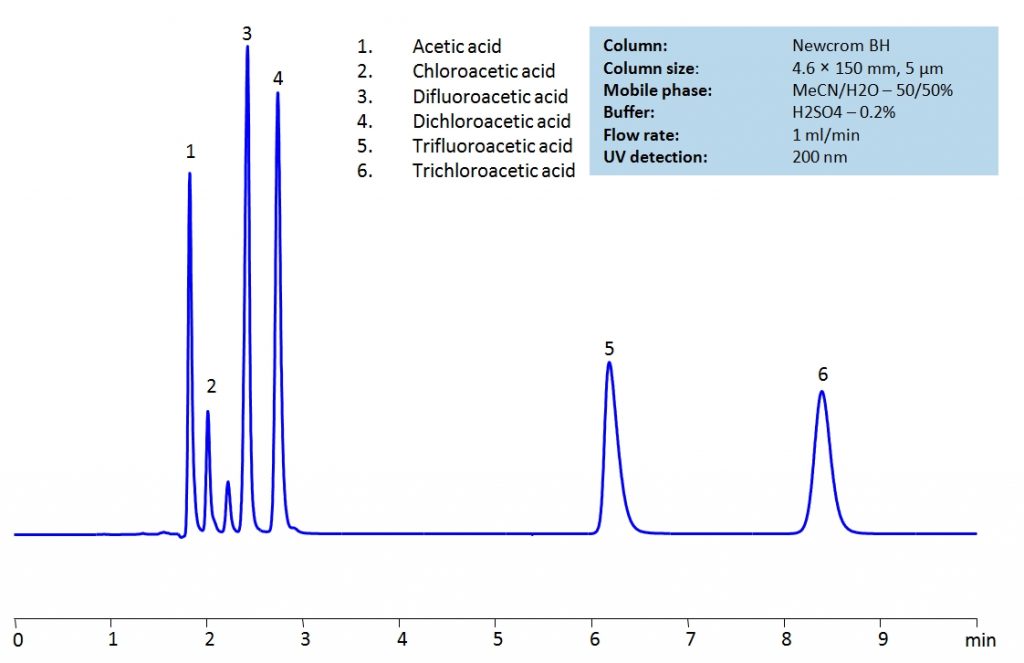
Acetic acid and its substitution derivatives, chloroacetic acid, dichloroacetic acid, trichloroacetic acid, difluoroacetic acid and trifluoroacetic acid, are heavily used as building blocks for more complex compounds in organic synthesis. All six acids can be isocratically separated in HPLC using Newcrom BH mixed-mode column with acetonitrile (ACN) and water mobile phase with sulfuric acid (H2SO4) as buffer and UV detected at 200nm.
| Column | Newcrom BH, 4.6×150 mm, 5 µm, 100A |
| Mobile Phase | MeCN/H2O – 50/50% |
| Buffer | H2SO4 – 0.2% |
| Flow Rate | 1.0 ml/min |
| Detection | UV 200nm |
| Class of Compounds | Acid |
| Analyzing Compounds | Acetic acid, Chloroacetic acid, Dichloroacetic acid, Trifluoroacetic acid (TFA), Trichloroacetic acid |
Application Column
Newcrom BH
The Newcrom columns are a family of reverse-phase-based columns. Newcrom A, AH, B, and BH are all mixed-mode columns with either positive or negative ion-pairing groups attached to either short (25 Å) or long (100 Å) ligand chains. Newcrom R1 is a special reverse-phase column with low silanol activity.
Select optionsChloroacetic acid
Dichloroacetic acid
Difluoroacetic acid
TFA (Trifluoroacetic Acid)
Trichloroacetic acid

HPLC Separation of Haloacetic acids on Newcrom BH Column
May 20, 2020
| Column | Newcrom BH, 4.6×150 mm, 5 µm, 100A |
| Mobile Phase | MeCN/H2O – 50/50% |
| Buffer | H2SO4 – 0.5% |
| Flow Rate | 1.0 ml/min |
| Detection | UV 200nm |
| Class of Compounds | Acid |
| Analyzing Compounds | Dichloroacetic acid, Trifluoroacetic acid (TFA), Trichloroacetic acid |
Application Column
Newcrom BH
The Newcrom columns are a family of reverse-phase-based columns. Newcrom A, AH, B, and BH are all mixed-mode columns with either positive or negative ion-pairing groups attached to either short (25 Å) or long (100 Å) ligand chains. Newcrom R1 is a special reverse-phase column with low silanol activity.
Select optionsTFA (Trifluoroacetic Acid)
Trichloroacetic acid

Separation of Dichloroacetic acid on Newcrom R1 HPLC column
February 16, 2018
Dichloroacetic acid can be analyzed by this reverse phase (RP) HPLC method with simple conditions. The mobile phase contains an acetonitrile (MeCN), water, and phosphoric acid. For Mass-Spec (MS) compatible applications the phosphoric acid needs to be replaced with formic acid. Smaller 3 µm particles columns available for fast UPLC applications. This liquid chromatography method is scalable and can be used for isolation impurities in preparative separation. It also suitable for pharmacokinetics.
Application Column
Newcrom R1
The Newcrom columns are a family of reverse-phase-based columns. Newcrom A, AH, B, and BH are all mixed-mode columns with either positive or negative ion-pairing groups attached to either short (25 Å) or long (100 Å) ligand chains. Newcrom R1 is a special reverse-phase column with low silanol activity.
Select options